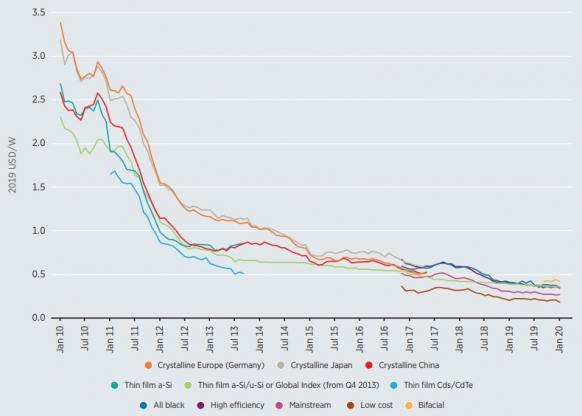Solar operators shun low-cost risks to extend lifespans
Revenue-hungry operators are expanding lifespan estimates despite a sharp fall in costs, showing an increasing confidence in post-warranty asset management.

Related Articles
A recent survey by the Lawrence Berkeley National Laboratory (Berkeley Lab) showed that the average life expectancy of US utility-scale PV projects rose to 32.5 years in 2019, compared with 21.5 years in 2007.
Module manufacturers now typically offer warranties of 25 or 30 years. Many plant owners expect lifespans over 35 years, while very few anticipate lifespans below 30 years, the survey showed.
The longer estimates come despite little operational data on long-term performance of PV plant components, particularly on newer models.
“The utility-scale solar market is really only ten years old," Joachim Seel, Senior Scientific Engineering Associate at Berkeley Lab, told New Energy Update.
"While cutting-edge module technology is stress-tested to estimate design life we don't have empirical data on how they actually perform after 30 years in the field,” he said.
Sharp falls in component and maintenance costs in recent years could impact these lifespan estimates, experts told New Energy Update. To manage these risks, operators are opting for shorter component warranties and taking greater control over maintenance and product testing.
Cost erosion
PV costs are continuing to fall as suppliers improve cell performance and plant layouts. The global average cost of mainstream module technology fell by 14% in 2019 to $0.27/W, the International Renewable Energy Agency (IRENA) said in its latest annual Renewable Power Generation Cost report. In the US, solar power purchase agreement (PPA) prices fell by 4.7% last year to an average of $27.40/MWh in Q4 2019, market platform provider LevelTen said. Operations and maintenance (O&M) costs have also fallen significantly in recent years and were estimated at between $5,000 and $8,000/MW/yr in 2019, the Berkeley Lab found.
PV module prices by technology, supplier country
(Click image to enlarge)
Source: IRENA's 'Renewable Power Generation Costs 2019' report.
PV components such as cells could last for as much as 50 years, but the drive for lower costs and lightweight designs could significantly shorten lifespans, Robin Hirschl, Technical Director at Danish renewable energy investor Obton, told New Energy Update.
Module suppliers have reduced the thickness of glass on the backsheet, which could affect robustness. Thinner module frames are also used, reducing mechanical stability, while connection boxes "use less material and hence possibly less protection," Hirschl said.
Glass and frame thickness are now fairly standardized and sometimes offer insufficient support for larger module profiles, Bryan Banke, Director of Asset Management at Adapture Renewables, said.
"They twist and undulate in high winds creating micro-cracks and stress fractures in the thin conductor busses and solder," he said.
Many operators will opt for major component overhauls as panel efficiency advances and other components succumb to weather conditions and electrical loads, Banke said.
“The models will be reworked and projects refinanced to pay for repowering and to reflect contemporary energy rates,” he said. "Most likely, future repowering will include storage to fundamentally change the way these systems deliver energy."
Factory faith
General improvements in manufacturing processes have driven longer lifespan assumptions, more than specific component gains, Jenya Meydbray, CEO at PV Evolution Labs (PVEL), told New Energy Update.
Increased automation in high-volume manufacturing has helped control quality, he said.
Growing learnings on joint degradation have also increased testing capabilities, Meydbray said.
"Over the past twenty years, the industry has amassed a large body of data about the reliability of solder joints and encapsulants in the field and how to accelerate this in a controlled laboratory environment," he said.
Pile corrosion must be managed to achieve longer lifespans. Piles typically only last around 20 to 25 years, depending on factors such as the corrosivity of the soil, the thickness of the pile and physical loading, Meydbray said.
Operators can extend lifespans by assessing corrosion levels and adding new piles to provide further strength. Another solution is using cathodic protection to pass electricity through the piles and reduce corrosivity.
"That’s thought to be more expensive at this time,” Meydbray noted.
Inverter swaps
Inverters typically represent 5 to 10% of project costs and are expected to be replaced at least once over the lifetime of the plant.
US solar O&M costs by category (2018)

Source: National Renewable Energy Laboratory (NREL).
On PV plants with 40 year term financial models, Adapture has inverter replacement reserves that "start funding in year 10 with expected use in year 20," Banke said.
Despite strong price pressure, inverter reliability has improved. New inverter designs can boost performance and provide additional reliability and maintenance benefits. In some cases, operators may choose to switch from large central inverters to string inverter systems.
“In reality, for central inverters, we will replace parts for each individual inverter until we no longer can,” Banke said.
Warranty risk
Panel and inverter suppliers have extended warranty lifespans but many operators are choosing shorter terms.
Warranties are useful for detecting manufacturing defects in the first few years of operations, but longer wear and tear issues may not be covered, Banke said.
“It’s more cost efficient to replace modules on your own dime than to jump through warranty hoops," he said.
Fears over supplier longevity also deter some operators from signing long-term warranties, particularly for inverters. Stockpiling of major components helps reduce spare parts risks if the supplier exits the market.
“That’s why we put such importance on accelerated lifetime testing," Jon Previtali, Director of Technology & Technical Service at Wells Fargo Renewable Energy & Environmental Finance (REEF), said.
"And other quality assurance/quality control methods like factory inspection and production oversight.”
Reporting by Neil Ford
Editing by Robin Sayles

